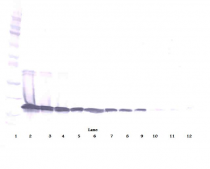ARG66063
anti-BAFF antibody (Biotin)
anti-BAFF antibody (Biotin) for ELISA,Western blot and Human
Overview
| Product Description | Biotin-conjugated Goat Polyclonal antibody recognizes BAFF |
|---|---|
| Tested Reactivity | Hu |
| Tested Application | ELISA, WB |
| Host | Goat |
| Clonality | Polyclonal |
| Isotype | IgG |
| Target Name | BAFF |
| Antigen Species | Human |
| Immunogen | E. coli derived recombinant Human BAFF. (AVQGPEETVT QDCLQLIADS ETPTIQKGSY TFVPWLLSFK RGSALEEKEN KILVKETGYF FIYGQVLYTD KTYAMGHLIQ RKKVHVFGDE LSLVTLFRCI QNMPETLPNN SCYSAGIAKL EEGDELQLAI PRENAQISLD GDVTFFGALK LL) |
| Conjugation | Biotin |
| Alternate Names | BLYS; TALL1; Dendritic cell-derived TNF-like molecule; THANK; DTL; TNF- and APOL-related leukocyte expressed ligand 1; TNFSF20; CD257; BLyS; Tumor necrosis factor ligand superfamily member 13B; ZTNF4; CD antigen CD257; B lymphocyte stimulator; TALL-1; BAFF; B-cell-activating factor |
Application Instructions
| Application Suggestion |
|
||||||
|---|---|---|---|---|---|---|---|
| Application Note | * The dilutions indicate recommended starting dilutions and the optimal dilutions or concentrations should be determined by the scientist. |
Properties
| Form | Liquid |
|---|---|
| Purification | Purified by affinity chromatography. |
| Buffer | PBS (pH 7.2) |
| Concentration | 1 mg/ml |
| Storage Instruction | Aliquot and store in the dark at 2-8°C. Keep protected from prolonged exposure to light. Avoid repeated freeze/thaw cycles. Suggest spin the vial prior to opening. The antibody solution should be gently mixed before use. |
| Note | For laboratory research only, not for drug, diagnostic or other use. |
Bioinformation
| Database Links |
Swiss-port # Q9Y275 Human Tumor necrosis factor ligand superfamily member 13B |
|---|---|
| Gene Symbol | TNFSF13B |
| Gene Full Name | tumor necrosis factor (ligand) superfamily, member 13b |
| Background | The protein encoded by this gene is a cytokine that belongs to the tumor necrosis factor (TNF) ligand family. This cytokine is a ligand for receptors TNFRSF13B/TACI, TNFRSF17/BCMA, and TNFRSF13C/BAFFR. This cytokine is expressed in B cell lineage cells, and acts as a potent B cell activator. It has been also shown to play an important role in the proliferation and differentiation of B cells. Alternatively spliced transcript variants encoding distinct isoforms have been identified. [provided by RefSeq, Mar 2011] |
| Function | Cytokine that binds to TNFRSF13B/TACI and TNFRSF17/BCMA. TNFSF13/APRIL binds to the same 2 receptors. Together, they form a 2 ligands -2 receptors pathway involved in the stimulation of B- and T-cell function and the regulation of humoral immunity. A third B-cell specific BAFF-receptor (BAFFR/BR3) promotes the survival of mature B-cells and the B-cell response. Isoform 2 seems to inhibit isoform 1 secretion and bioactivity. Isoform 3: Acts as a transcription factor for its own parent gene, in association with NF-kappa-B p50 subunit, at least in autoimmune and proliferative B-cell diseases. The presence of Delta4BAFF is essential for soluble BAFF release by IFNG/IFN-gamma-stimulated monocytes and for B-cell survival. It can directly or indirectly regulate the differential expression of a large number of genes involved in the innate immune response and the regulation of apoptosis. [UniProt] |
| Calculated MW | 31 kDa |
| PTM | The soluble form derives from the membrane form by proteolytic processing. Isoform 2 is not efficiently shed from the membrane unlike isoform 1. N-glycosylated. |
Images (3) Click the Picture to Zoom In
-
ARG66063 anti-BAFF antibody (Biotin) WB image
Western blot: 250 - 0.24 ng of Human BAFF stained with ARG66063 anti-BAFF antibody (Biotin), under reducing conditions.
-
ARG66063 anti-BAFF antibody (Biotin) standard curve image
Direct ELISA: ARG66063 anti-BAFF antibody (Biotin) at 0.25 - 1.0 µg/ml results of a typical standard run with optical density reading at 405 - 650 nm.
-
ARG66063 anti-BAFF antibody (Biotin) standard curve image
Sandwich ELISA: ARG66063 anti-BAFF antibody (Biotin) as a detection antibody at 0.25 - 1.0 µg/ml combined with ARG66062 anti-BAFF antibody as a capture antibody. Results of a typical standard run with optical density reading at 405 - 650 nm.








